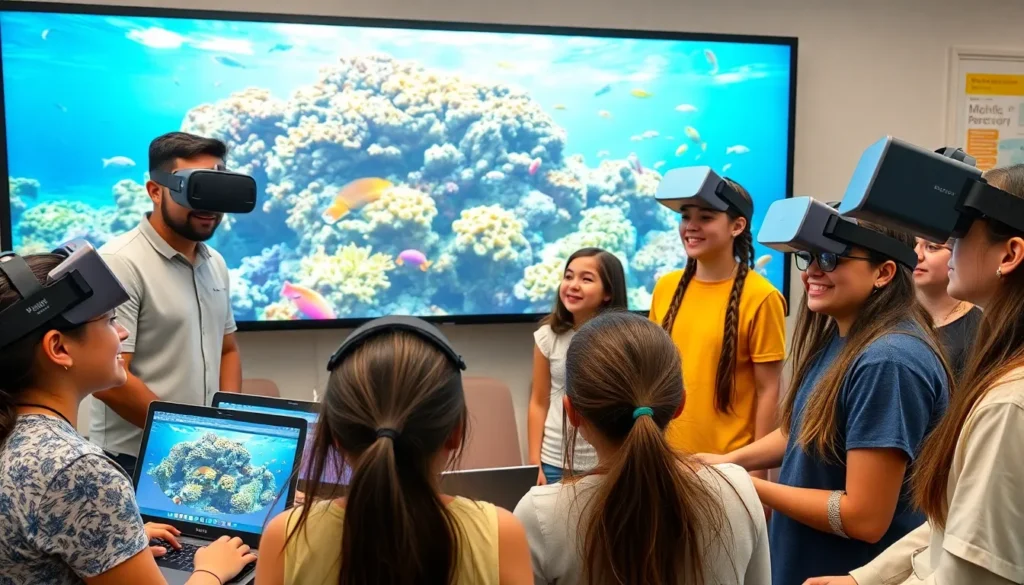Table of Contents
ToggleIn the bustling halls of education, school leadership is the secret sauce that can turn a mediocre institution into a thriving learning hub. Think of school leaders as the captains of a ship navigating the often choppy waters of curriculum changes, budget cuts, and the occasional rogue student with a penchant for pranks. Their role isn’t just about enforcing rules; it’s about inspiring teachers and students alike to reach for the stars while keeping a sense of humor intact.
Effective school leadership can foster an environment where creativity flourishes and academic achievement soars. With the right leader at the helm, schools can transform into vibrant communities where everyone feels valued. So, whether you’re a seasoned principal or a hopeful future leader, understanding the nuances of school leadership is crucial. Let’s dive into what makes these educational superheroes tick and how they can make a lasting impact on their schools.
Overview of School Leadership
School leadership plays a crucial role in shaping educational success. Leaders in schools often steer their institutions through both challenges and opportunities. Effective school leaders engage with teachers, students, and the community to foster a positive learning environment. They motivate staff to innovate and improve instructional practices, thereby enhancing student performance.
Research indicates that strong leadership correlates with improved student achievement. For instance, schools with effective leaders tend to demonstrate higher test scores and graduation rates. A focus on collaborative leadership styles can further empower educators. Engaging teachers in decision-making processes enriches professional development and nurtures a sense of ownership among staff.
School leaders also prioritize building relationships. They create a culture of trust and respect, ensuring that all stakeholders feel valued. By implementing open communication channels, leaders can address concerns and share successes with the community. Listening to feedback enables leaders to adapt initiatives that directly impact students and educators.
Decision-making skills stand out as a vital characteristic of effective school leaders. They assess data and use it strategically to inform their choices. Resource allocation, curriculum development, and staff recruitment require informed strategies that align with school goals. Consistently revisiting these strategies ensures schools remain responsive to the evolving educational landscape.
Emphasizing continuous improvement, successful leaders seek professional development opportunities for themselves and their staff. They model lifelong learning, encouraging others to pursue growth. Through these dedicated efforts, school leadership directly influences the overall educational climate, contributing to a thriving academic community.
Importance of School Leadership

School leadership plays a critical role in shaping educational outcomes. Effective leaders directly influence the trajectory of their institutions.
Impact on Student Achievement
Research establishes a direct link between strong leadership and heightened student achievement. Schools overseen by capable leaders often report better test scores and increased graduation rates. Such leaders cultivate an environment where teachers feel motivated to innovate and refine their instructional techniques. Engagement with the community, teachers, and students fosters accountability and support, driving academic excellence. Leaders who prioritize data-driven decision-making ensure resources align with student needs, further enhancing performance.
Influence on School Culture
School culture thrives under effective leadership. Leaders create an inclusive atmosphere that values collaboration and trust. They promote a sense of belonging among students and staff alike. Open communication channels allow stakeholders to voice their opinions, fostering a shared responsibility for success. Techniques such as empowering educators through involvement in decision-making nurture professional growth. Respectful relationships between leaders and staff contribute to a positive environment, motivating everyone to collaborate towards common goals.
Types of School Leadership Styles
School leaders employ various leadership styles, each with distinct characteristics that impact their institutions significantly.
Transformational Leadership
Transformational leaders inspire change by promoting a shared vision for the school community. They motivate educators to innovate and excel, fostering a culture of growth among teachers and students. This leadership style encourages collaboration, leading to increased engagement in instructional practices. Research indicates schools led by transformational leaders often achieve higher student engagement and satisfaction. By cultivating relationships built on trust, these leaders help staff feel valued and empowered, resulting in a positive school culture.
Instructional Leadership
Instructional leaders focus on enhancing teaching and learning processes. Their primary goal involves improving classroom instruction to increase student achievement. By regularly observing classroom activities, these leaders provide constructive feedback to teachers. Data-driven decision-making serves as a foundation for their strategies, ensuring that resource allocation supports effective instruction. Elevating professional development opportunities plays a crucial role, as these leaders aim to strengthen instructional techniques and foster ongoing improvement efforts.
Servant Leadership
Servant leaders prioritize the needs of their staff and students, promoting a supportive environment. They demonstrate empathy, putting the welfare of others first. This style encourages open communication, allowing all stakeholders to share their thoughts and concerns. Building a sense of community becomes central, as servant leaders work to enhance relationships among staff, students, and parents. Research suggests organizations led by servant leaders experience increased trust and collaboration, ultimately fostering a thriving educational environment.
Challenges in School Leadership
School leaders face numerous challenges that can impede their ability to create effective educational environments. Recognizing these obstacles plays a crucial role in developing strategies for overcoming them.
Navigating Change
Change in education occurs rapidly, often due to new policies, updated curricula, or shifts in funding. School leaders must adapt quickly to these alterations, ensuring their staff and students understand and embrace the changes. Communication becomes vital during transitions, as leaders must clarify the reasons behind changes. Successful navigation of change entails promoting a culture where feedback is welcomed, allowing for adjustments that meet the needs of students and educators alike. Inadequate attention to these elements may result in resistance among staff and students.
Building Effective Teams
Creating strong teams within schools is essential for success. Leaders must unite educators with diverse strengths and perspectives, fostering a collaborative atmosphere. Establishing clear roles helps team members understand their contributions and responsibilities. Regular professional development opportunities enable continuous growth, while shared goals encourage collective ownership of the school’s mission. A supportive environment further enhances team dynamics, as trust and respect generate effective communication. When teams flourish, they positively impact student learning and overall school climate.
Future Trends in School Leadership
Emerging trends in school leadership reflect the evolving educational landscape. Most school leaders prioritize technology integration to enhance classroom experiences. They emphasize utilizing digital tools for collaboration and communication among staff and students. Prioritizing data-driven decision-making continues to play a crucial role in improving school performance. Leaders analyze student performance metrics to tailor curricula and instructional strategies effectively.
Innovative leadership styles are gaining traction. Transformational leaders inspire vision and foster collaboration, while instructional leaders focus on continuous improvement in teaching methodologies. Servant leadership is recognized for its emphasis on meeting the needs of both staff and students, promoting a culture of support. Increasingly, school leaders incorporate social-emotional learning into their strategies to address students’ holistic needs.
Collaboration among educators remains a focal point. Strong leaders facilitate professional learning communities where teachers share best practices and support one another. Regular feedback loops are essential, allowing staff to engage in reflective practices that enhance their capabilities. Community partnerships also grow in importance; school leaders engage with local organizations to expand resources and support for students.
Inclusive leadership practices gain momentum in promoting equity and diversity in schools. Leaders actively seek diverse perspectives among staff and students, fostering a sense of belonging. Open communication channels help bridge gaps and address concerns transparently. Sustainable leadership practices are key; school leaders commit to long-term development and continuous improvement.
Shifts in educational policies influence leadership strategies. School leaders navigate changes by maintaining a responsive and adaptive approach to challenges. Communication plays a vital role in ensuring staff and students understand new initiatives. Building resilience within school teams proves essential for navigating the complexities of modern education. Through these trends, future school leadership will continue to evolve, ensuring that institutions thrive in an increasingly dynamic environment.
Strong school leadership is essential for fostering thriving educational environments. As leaders navigate challenges and embrace opportunities they directly influence both teacher engagement and student success. By prioritizing collaboration inclusivity and continuous improvement they create a culture where everyone feels valued and motivated.
Emerging trends in school leadership highlight the importance of technology integration and data-driven decision-making. As schools adapt to changing educational landscapes effective leaders will need to maintain open communication and resilience. The future of school leadership hinges on the ability to inspire innovation and cultivate a supportive community that prioritizes the holistic needs of all students.










